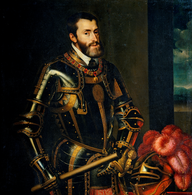Down: The empire of Charles V at its peak after the Peace of Crépy in 1544.
The Empire of Charles V, also known by the umbrella term Habsburg Empire, included the Holy Roman Empire, the Spanish empire, the Burgundian Low Countries, the Austrian lands, and all the territories and dominions ruled in personal union by Charles V from 1519 to 1556. It was the first to be labelled as "the empire on which the sun never sets", a term used to describe several global empires throughout history. The lands of the empire had in common only the monarch, Charles V, while their boundaries, institutions, and laws remained distinct. Charles's nomenclature as Holy Roman Emperor was Charles V (also Karl V and Carolus V), though earlier in his life he was known by the names of Charles of Ghent (after his birthplace in Flanders), Charles II as Duke of Burgundy, and Charles I as King of Spain (Carlos I) and Archduke of Austria (Karl I). The imperial name prevailed due to the politico-religious primacy held by the Holy Roman Empire among European monarchies since the Middle Ages, which Charles V intended to preserve as part of his (ultimately failed) project to unite Christendom under his leadership.[1][2][3][4]
Charles V inherited the states comprising his empire as a result of the ambitious Habsburg matrimonial policy, engaged in extensive warfare during his reign, especially against Francis I of France and Francis I's Muslim ally, Ottoman ruler Suleiman the Magnificent, and had to face the Protestant Reformation of Martin Luther. His empire expanded in the Americas with the Spanish conquest of the Aztec Empire and the Inca Empire. He had access to vast resources consisting of flows of silver from the Americas to Spain, loans received from German and Italian bankers, and financial revenues of his states, especially the rich Low Countries; he used this wealth to wage war in Europe, but failed to contain religious divisions and French and Ottoman hostility, while his regime became more and more indebted and suffered from inflation. Ruling a vast empire as an itinerant monarch, he was assisted by many collaborators and entrusted oversight of his realms to his close relatives; ultimately he abdicated and divided the component states of his empire, with his brother Ferdinand succeeding him as Holy Roman Emperor and his son Philip inheriting the Spanish territories and the Low Countries.
- ^ For the same reason, the term "Imperial" was used as the corresponding adjective (E.G. Imperial army, Imperial court, Imperial victory) and the followers of Charles V were described as "the Imperials."
- ^ Simpson, L. F., Baron Kervyn de Lettenhove, J. M. B. C.; The Autobiography of the Emperor Charles V
- ^ Blockmans, W. P., and Nicolette Mout. The World of Emperor Charles V (2005)
- ^ Brandi, Karl. The emperor Charles V: The growth and destiny of a man and of a world-empire (1939)
© MMXXIII Rich X Search. We shall prevail. All rights reserved. Rich X Search


